Waffling Around
QUESTION:
I recently purchased an old electric waffle iron
at a garage sale. Are these things collectible and can I still
use it?
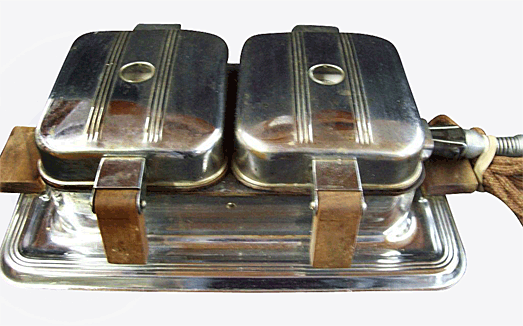
Thanks,
Clara
____________________________________________________
ANSWER:
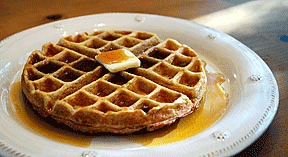 Mmmmmmm.
Just the mention of waffles reminds any people of the smell of them
baking on a cold Sunday morning, then smothered in butter and warm maple
syrup, and perhaps topped with strawberries and whipped cream. Mmmmmmm.
Just the mention of waffles reminds any people of the smell of them
baking on a cold Sunday morning, then smothered in butter and warm maple
syrup, and perhaps topped with strawberries and whipped cream.
Depending on the age of an electric waffle iron, it has the potential to
be collectible. Small appliances like this are just coming into their
own as collectibles. However, for those who plan to use a waffle iron,
they should have the appliance checked out and the wire replaced with a
higher-voltage cord by a certified appliance repair dealer. Once that’s
done and the waffle iron cleaned up, it will be ready to make delicious
old-time waffles.
Before the waffle iron became electrified, the making of waffles had an
interesting history. Traditional waffle irons consisted of two hinged
metal plates, molded to create a honeycomb pattern, attached to two long
handles which the maker held over a wood fire to bake the batter poured
between them, one side at a time. Knowing when to turn the iron took
skill learned by trial and error since these early waffle irons had no
temperature controls.
History of the Waffle Iron
Some historians believe the waffle dates back to ancient Greece, when
Athenians baked obelios—flat cakes held between two metal plates—over
hot coals. The word waffle evolved from wafer, one of the only foods
early Catholics could eat during fasting periods because they contained
no milk, eggs, or animal fats. Monks were the only ones making these
wafers until the late 12th century, when lay bakeries began making a
tastier version which they called “waffres,” which meant flat, honeycomb
cakes.
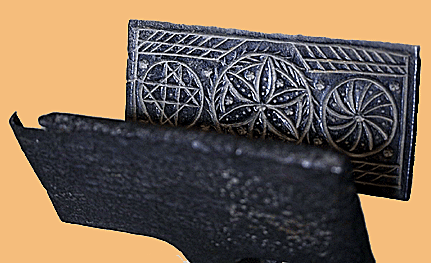
Eventually, waffle iron makers molded the plates with religious symbols
and the familiar honeycomb pattern, which originally meant to represent
interlocking crosses. In 1270, a guild to train the street vendors who
sold waffles came into existence.
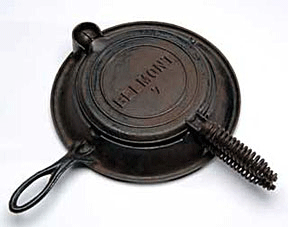 Peasants
soon began making their own flour and water waffles, although some
started adding eggs and honey to make them lighter and sweeter. Even
Geoffrey Chaucer mentions waffles in his Canterbury Tales: "He sent her
sweetened wine and well-spiced ale/ And waffles piping hot out of the
fire." Peasants
soon began making their own flour and water waffles, although some
started adding eggs and honey to make them lighter and sweeter. Even
Geoffrey Chaucer mentions waffles in his Canterbury Tales: "He sent her
sweetened wine and well-spiced ale/ And waffles piping hot out of the
fire."
Waffles became a staple of the Dutch diet by the 1620s and early
immigrants brought them to New Amsterdam, eventually to become New York.
In the 18th century, slaves who were cooks were responsible for making
waffles. African-Americans became highly skilled at making them, and the
first cookbook ever written by an African-American, published in
1881,contains a waffle recipe. And slaves also made waffles for
themselves. Waffles were expensive and time-consuming to make, but the
slaves combined them with leftover chicken to make an exotic dish that
came to be a special-occasion meal in African American families.
But the waffle wouldn’t achieve nationwide appeal until Thomas Jefferson
brought a waffle iron back from France in the 1790s as a souvenir. He
had his cook make and serve them at the White House, which helped
popularize "waffle parties."
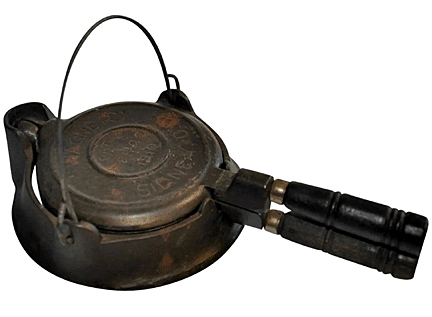 It
wasn’t until 1869 that Cornelius Swarthout patented the first waffle
iron in the U.S. What made his waffle iron unique was that he joined the
cast iron plates by a hinge that swiveled in a cast-iron collar. It
wasn’t until 1869 that Cornelius Swarthout patented the first waffle
iron in the U.S. What made his waffle iron unique was that he joined the
cast iron plates by a hinge that swiveled in a cast-iron collar.
Soon after the invention of electricity in the late 1860s came the
electric waffle iron. Lucas D. Sneeringer of New Oxford, Pennsylvania,
designed the first electric heating elements that used a built-in
thermostat to prevent overheating, a common problem with early versions.
With his revolutionary design and General Electric funding, the first
electric waffle iron rolled off the assembly line on July 26, 1911.
Most modern waffle irons are self-contained tabletop electrical
appliances, heated by an electric heating element controlled by an
internal thermostat. Many have a light that goes off when the iron is at
the set temperature. Most modern waffle irons are coated with a
non-stick coating to prevent the waffles from sticking to them.
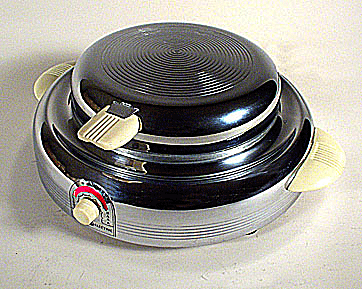 In
1918 housewives were clamoring for one of those newfangled electric
waffle irons advertised by Landers, Fray and Clark. By the 1930,
manufacturers introduced round chrome and steel irons, newly stylized
with an Art Deco flair and imaginative porcelain tile inserts or
Bakelite handles. The late 1940s and early 1950s brought cooks the
option of square waffles and the reversible grid, which converted from
waffle iron to sandwich grill. In
1918 housewives were clamoring for one of those newfangled electric
waffle irons advertised by Landers, Fray and Clark. By the 1930,
manufacturers introduced round chrome and steel irons, newly stylized
with an Art Deco flair and imaginative porcelain tile inserts or
Bakelite handles. The late 1940s and early 1950s brought cooks the
option of square waffles and the reversible grid, which converted from
waffle iron to sandwich grill.
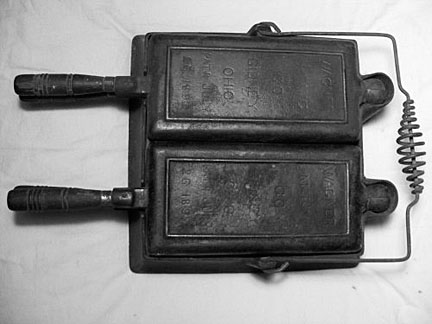 While
the first electric waffle iron did the job—the process of making waffles
this way is a relatively simple one—it didn’t look very pretty. So
designers set about making the exterior of the waffle iron more
attractive. Other innovations, like an iron that could cook two waffles
at the same time, soon followed. Charles M. Cole invented the first twin
waffle iron in 1926, but it wasn’t until 1939 when Karl Ratliff designed
the "Twin-O-Matic" for the New York World's fair that it really caught
on with the public. While
the first electric waffle iron did the job—the process of making waffles
this way is a relatively simple one—it didn’t look very pretty. So
designers set about making the exterior of the waffle iron more
attractive. Other innovations, like an iron that could cook two waffles
at the same time, soon followed. Charles M. Cole invented the first twin
waffle iron in 1926, but it wasn’t until 1939 when Karl Ratliff designed
the "Twin-O-Matic" for the New York World's fair that it really caught
on with the public.
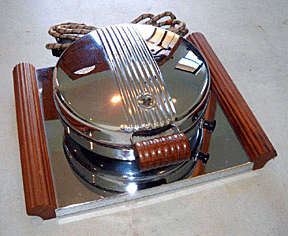 By
the time the 1939 New York World’s Fair rolled around, Art Deco design
had influenced everything from dishes to utensils and small appliances.
Some waffle irons, like the Hotpoint waffle iron by Edison General
Electric, became works of art in themselves. Some resembled flying
saucers, having lost their legs and taking on a lower, sleeker look. One
of these was General Electric’s Diana, designed by August Propernick.
Toastmaster and Sunbeam soon got in on the act and began producing their
own electric waffle irons. By
the time the 1939 New York World’s Fair rolled around, Art Deco design
had influenced everything from dishes to utensils and small appliances.
Some waffle irons, like the Hotpoint waffle iron by Edison General
Electric, became works of art in themselves. Some resembled flying
saucers, having lost their legs and taking on a lower, sleeker look. One
of these was General Electric’s Diana, designed by August Propernick.
Toastmaster and Sunbeam soon got in on the act and began producing their
own electric waffle irons.
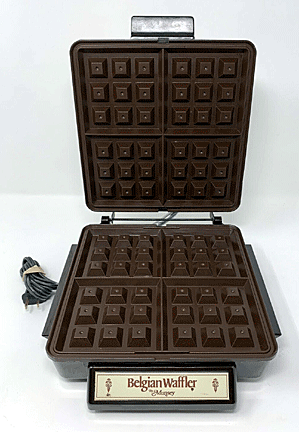 While
there is no set standard of classification for waffle shapes or
thicknesses, models that fall within the most common shapes and
thicknesses are often labeled as "traditional" or "classic". Models that
make thicker and/or larger pocketed waffles are often labeled as
"Belgian" waffle makers. In 1964 Maurice Vermersch introduces the
Brussels waffle recipe at the 1964 New York World's Fair. While
there is no set standard of classification for waffle shapes or
thicknesses, models that fall within the most common shapes and
thicknesses are often labeled as "traditional" or "classic". Models that
make thicker and/or larger pocketed waffles are often labeled as
"Belgian" waffle makers. In 1964 Maurice Vermersch introduces the
Brussels waffle recipe at the 1964 New York World's Fair.
Later waffle irons lost their legs and stands and became lower and
sleeker, some resembling flying saucers. A favorite Art Deco design is
GE's Diana, designed by industrial designer August Propernick and
produced for 12 years. Other models include a long-popular Toastmaster
Model 2D2 automatic chrome-plated waffle iron manufactured from 1939 to
1959, selling for $195, and the Sunbeam CG Waffle Iron from the
mid-1950s, featuring removable cooking grids for waffles and optional
flat grilling plates, for $135.
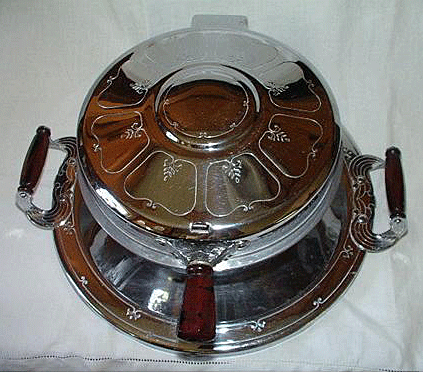 One
of the best things about collecting old electric waffle irons is that
many still work perfectly. Electric appliances from the 1930s to the
1960s were designed to last, and lots of them are almost as good as new.
All that heavy chrome cleans up beautifully and the stylized shapes make
a desirable "retro"statement in today's kitchen. Names like General
Electric, Westinghouse, and Hotpoint(by GE). Of course, any frayed or
questionable wiring should be replaced before use. One
of the best things about collecting old electric waffle irons is that
many still work perfectly. Electric appliances from the 1930s to the
1960s were designed to last, and lots of them are almost as good as new.
All that heavy chrome cleans up beautifully and the stylized shapes make
a desirable "retro"statement in today's kitchen. Names like General
Electric, Westinghouse, and Hotpoint(by GE). Of course, any frayed or
questionable wiring should be replaced before use.
<
Back to Readers Ask Archives
Next Article > |
